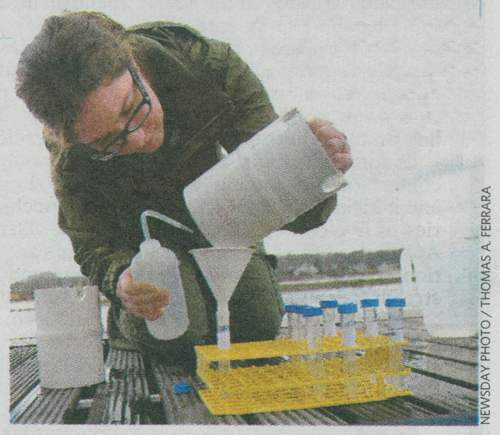Stony Brook, NY, March 30, 2012 - Winter may have been gentle on Long Island this past season, but, as detailed in a
Newsday article from earlier this month ("Love the Mild Winter? Here's What Might Be Next,"
pdf), milder months may lead to hardships this spring and summer.
Experts say to expect more insects buzzing around, an increase in algal blooms in coastal waters and an earlier start to the watery eyes and stuffy nose torment of allergy season. Also, with fewer winter storms to stir up wind gusts and waves, Long Island's shoreline received a much-needed reprieve, says Henry Bokuniewicz, a professor at Stony Brook University's (SBU) School of Marine and Atmospheric Sciences (SOMAS)
Another one of the experts featured is Dr. Christopher Gobler, a SBU researcher and professor at SOMAS. According to the
Newsday article, if the past is any indication, the warmer winter may lead to a larger spread of algal blooms commonly referred to as red and brown tide. "When it's been warmer in the spring, like 2008 and 2010, we've had red tide emerge earlier," Gobler said. "It can also be more intense like in 2008, which lead to large shellfish bed closures earlier."
Gobler said North Shore areas like Huntington and Northport will be more susceptible to red tide, while Great South Bay on the South Shore will be more prone to brown tide. "This could have a negative impact on those who make their livelihood harvesting shellfish," he said.
In a two-year New York Sea Grant and Long Island Sound Study-funded project completed in early 2011, Gobler examined the harmful algal bloom
Alexandrium fundyense in nearshore and open water regions of Long Island Sound. Gobler’s focus was on the distribution, causes and impacts of this red tide algae, a serious, emerging human health threat that causes paralytic shellfish poisoning (PSP). For more on this project, see NYSG's related news item (
click here).
 Theresa Hattenrath - Lehmann, a Sea Grant scholoar on one of Dr. Chris Gobler's NYSG-funded studies, takes water samles from Northport Harbor.
Theresa Hattenrath - Lehmann, a Sea Grant scholoar on one of Dr. Chris Gobler's NYSG-funded studies, takes water samles from Northport Harbor.
Last fall, Gobler began leading partners in another project - this one an anticipated $600,000 grant from the National Oceanic and Atmospheric Administration (NOAA, Sea Grant's parent organization) - to investigate enhanced water monitoring technologies and early warning methods to help New York State respond to its growing toxic algae bloom problem.
In five of the last six years, blooms of
Alexandrium and high levels of PSP toxin in shellfish forced the closure of nearly 7,500 acres of prime shellfish beds on Huntington Bay and Northport Bay on Long Island’s north shore. In 2011, PSP-related closures were necessary in 3,900 acres of Shinnecock Bay along the south shore of Long Island creating an unanticipated threat to oyster aquaculture operations of the Shinnecock Indian Nation.
In the last three years, New York’s harmful algal bloom problem expanded with the appearance of large, annual blooms of another toxic algae species,
Dinophysis acuminata, along the north shore. Toxins produced by this species can also accumulate in shellfish and when eaten cause the human illness known as diarrhetic shellfish poisoning (DSP) syndrome.
“This project will have a series of benefits to the citizens of New York," said Gobler. "First and foremost, when PSP or DSP events occur our efforts will improve our abilities to protect human health. In addition, our rapid monitoring and accurate analyses will allow nearby regions that do not have high levels of harmful algal toxins to remain open to shellfishing.”
For more on this NOAA-funded harmful algal blooms research, see NYSG's related news item (
click here).
New York Sea Grant is one of 32 university-based programs under the National Sea Grant College Program of the National Oceanic and Atmospheric Administration (NOAA), a cooperative program of the State University of New York and Cornell University. The National Sea Grant College Program utilizes this network of the nation's premier universities in conducting scientific research, education, training and extension projects designed to encourage science-based decisions about the use and conservation of our aquatic resources.